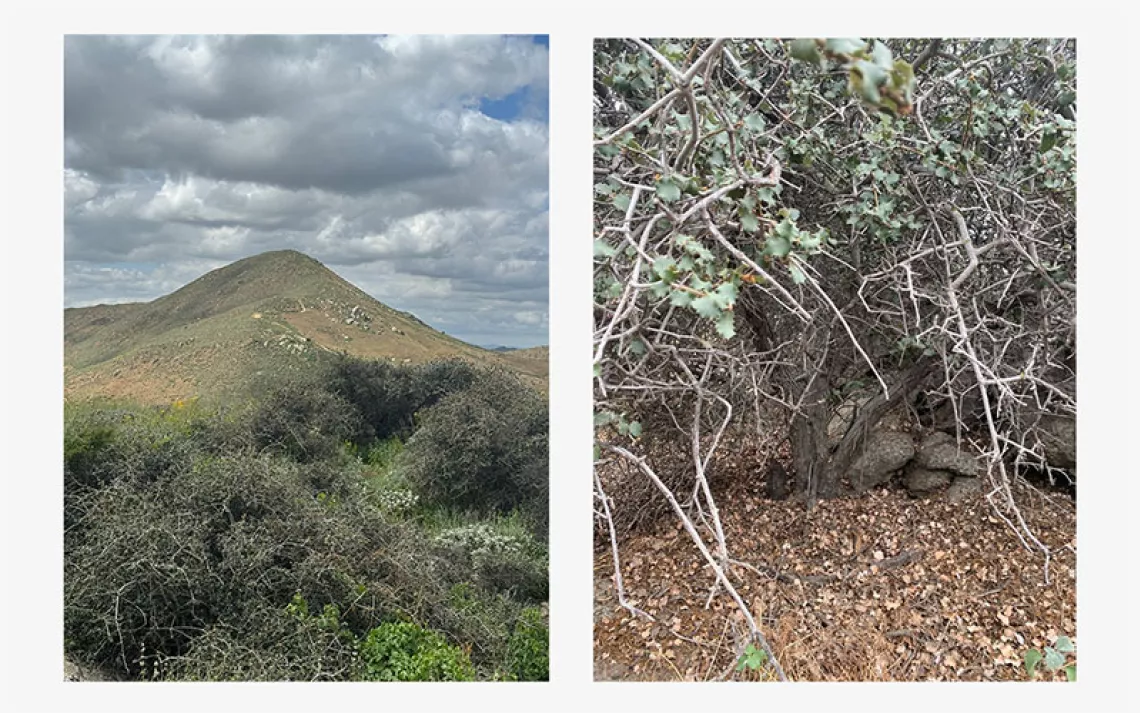A Desert Meditation on the Future of Solar
Can we have our clean energy installations and our desert too?

Illustration by Emily Whang
IN SPRING 1844, John C. Frémont dropped from the Tehachapi Mountains into what is now known as the Antelope Valley in Southern California. As he neared the location where my father-in-law Jim’s house now sits, he recounted, “We descended to a kind of plain among the lower spurs; the desert being in full view on our left, apparently illimitable. . . . ‘There,’ said our guide, stretching out his hand towards it, ‘There are the great llanos. No hay agua; no hay zacaté—nada.’”
No water; no grass—nothing.
Frémont’s guide was mistaken. The western Mojave Desert had been home to the Kitanemuk, Serrano, and Tataviam peoples since time immemorial. During Frémont’s time, herds of pronghorn and mule deer galloped through tall bunchgrass and brilliant fields of poppies. Joshua trees poked up from the plain by the thousands. Frémont considered their “stiff and ungraceful” form “repulsive” to desert travelers.
Strangers often find the desert to be inscrutable, and misunderstanding gives way to fear and disdain. That, I suppose, is why so many have been so quick to sacrifice these expanses.
Jim’s place, Dead Dog Ranch, has a million-dollar view of Frémont’s so-called nothingness. Like many of the dwellings out here, Jim’s is off the grid. Solar panels and a few golf-cart batteries power the spread, not because Jim worries about the warming climate but because he likes his freedom and wants to be prepared if that seething mass of 13 million people on the other side of the mountains ever starts to digest itself. Dead Dog Ranch will be a fine place for toasting the sunset of civilization.
The view from Jim’s porch is, indeed, vaguely apocalyptic. The ancient lakes dried up long ago, becoming dust-billowing motorhead sacrifice zones. Groundwater pumping and diversions desiccated the Mojave River, and the pronghorn died off or fled. Now it’s a landscape of prisons and gravel mines, enigmatic industrial facilities, developers’ broken dreams. But none of it can diminish the beauty that simmers amid it all, revealing itself only to those who slow down and pay attention. I often wonder whether Frémont’s misunderstanding of the desert as a lifeless void was honest—or an intentional ruse to justify the abuse that would follow.
The latest assault is playing out 30 miles north of Jim’s place, near the mining town of Boron, where a developer is building a 2,300-acre solar array. When completed, the facility will generate enough carbon-free electricity to power 180,000 homes. It will also require the destruction of at least 3,500 Joshua trees. While some lament the trees’ deaths, others argue that we need all the clean energy we can get to possibly save the Joshua tree species from climate-wrought extinction.
But what if, instead of the solar panels displacing fossil fuel generation, the new clean power is all guzzled up by data centers, Sunbelt air conditioners, and cryptocurrency mining operations? What if the trees are mowed down only to have gas and coal plants continue to churn out planet-warming pollution? Will we commit yucca-cide solely for the sake of Bitcoin and AI queries?
I step off Jim’s porch, wander into the sandy bed of an arroyo, and follow it into the nothing. I find delicate Indian ricegrass fluttering in the breeze and pink-purple desert sand verbena blossoms celebrating the recent rain. And there, on the crest of a hill, a scissor-handed anthropoid, the Joshua tree. It seems to be in motion, maybe dancing, maybe pleading with me to save it from the bulldozer’s cold blade. But as I approach, I realize it is not looking for help, but wildly gesturing at me and my kind to, at long last, just go away and leave it alone.
 The Magazine of The Sierra Club
The Magazine of The Sierra Club



